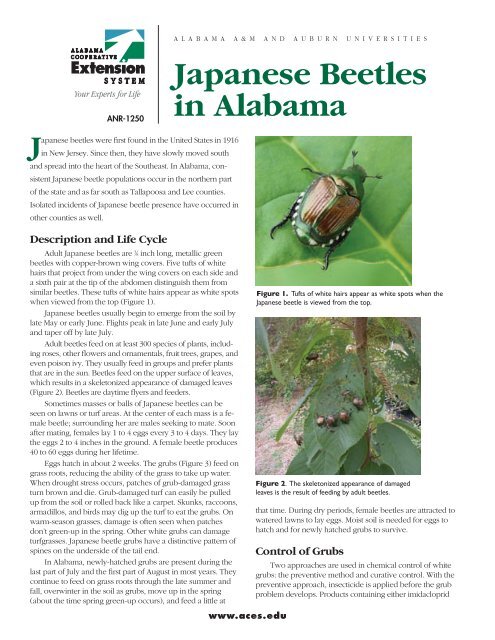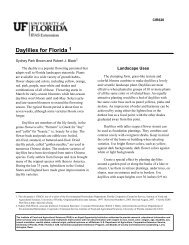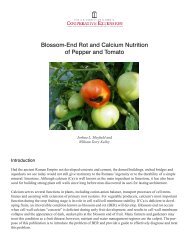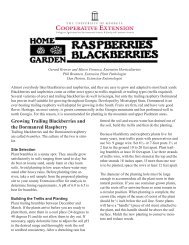Japanese Beetles in Alabama - Your Southern Garden
Japanese Beetles in Alabama - Your Southern Garden
Japanese Beetles in Alabama - Your Southern Garden
Create successful ePaper yourself
Turn your PDF publications into a flip-book with our unique Google optimized e-Paper software.
A L A B A M A A & M A N D A U B U R N U N I V E R S I T I E S<br />
ANR-1250<br />
<strong>Japanese</strong> <strong>Beetles</strong><br />
<strong>in</strong> <strong>Alabama</strong><br />
<strong>Japanese</strong> beetles were first found <strong>in</strong> the United States <strong>in</strong> 1916<br />
<strong>in</strong> New Jersey. S<strong>in</strong>ce then, they have slowly moved south<br />
and spread <strong>in</strong>to the heart of the Southeast. In <strong>Alabama</strong>, consistent<br />
<strong>Japanese</strong> beetle populations occur <strong>in</strong> the northern part<br />
of the state and as far south as Tallapoosa and Lee counties.<br />
Isolated <strong>in</strong>cidents of <strong>Japanese</strong> beetle presence have occurred <strong>in</strong><br />
other counties as well.<br />
Description and Life Cycle<br />
Adult <strong>Japanese</strong> beetles are 3 ⁄8 <strong>in</strong>ch long, metallic green<br />
beetles with copper-brown w<strong>in</strong>g covers. Five tufts of white<br />
hairs that project from under the w<strong>in</strong>g covers on each side and<br />
a sixth pair at the tip of the abdomen dist<strong>in</strong>guish them from<br />
similar beetles. These tufts of white hairs appear as white spots<br />
when viewed from the top (Figure 1).<br />
<strong>Japanese</strong> beetles usually beg<strong>in</strong> to emerge from the soil by<br />
late May or early June. Flights peak <strong>in</strong> late June and early July<br />
and taper off by late July.<br />
Adult beetles feed on at least 300 species of plants, <strong>in</strong>clud<strong>in</strong>g<br />
roses, other flowers and ornamentals, fruit trees, grapes, and<br />
even poison ivy. They usually feed <strong>in</strong> groups and prefer plants<br />
that are <strong>in</strong> the sun. <strong>Beetles</strong> feed on the upper surface of leaves,<br />
which results <strong>in</strong> a skeletonized appearance of damaged leaves<br />
(Figure 2). <strong>Beetles</strong> are daytime flyers and feeders.<br />
Sometimes masses or balls of <strong>Japanese</strong> beetles can be<br />
seen on lawns or turf areas. At the center of each mass is a female<br />
beetle; surround<strong>in</strong>g her are males seek<strong>in</strong>g to mate. Soon<br />
after mat<strong>in</strong>g, females lay 1 to 4 eggs every 3 to 4 days. They lay<br />
the eggs 2 to 4 <strong>in</strong>ches <strong>in</strong> the ground. A female beetle produces<br />
40 to 60 eggs dur<strong>in</strong>g her lifetime.<br />
Eggs hatch <strong>in</strong> about 2 weeks. The grubs (Figure 3) feed on<br />
grass roots, reduc<strong>in</strong>g the ability of the grass to take up water.<br />
When drought stress occurs, patches of grub-damaged grass<br />
turn brown and die. Grub-damaged turf can easily be pulled<br />
up from the soil or rolled back like a carpet. Skunks, raccoons,<br />
armadillos, and birds may dig up the turf to eat the grubs. On<br />
warm-season grasses, damage is often seen when patches<br />
don’t green-up <strong>in</strong> the spr<strong>in</strong>g. Other white grubs can damage<br />
turfgrasses. <strong>Japanese</strong> beetle grubs have a dist<strong>in</strong>ctive pattern of<br />
sp<strong>in</strong>es on the underside of the tail end.<br />
In <strong>Alabama</strong>, newly-hatched grubs are present dur<strong>in</strong>g the<br />
last part of July and the first part of August <strong>in</strong> most years. They<br />
cont<strong>in</strong>ue to feed on grass roots through the late summer and<br />
fall, overw<strong>in</strong>ter <strong>in</strong> the soil as grubs, move up <strong>in</strong> the spr<strong>in</strong>g<br />
(about the time spr<strong>in</strong>g green-up occurs), and feed a little at<br />
www.aces.edu<br />
Figure 1. Tufts of white hairs appear as white spots when the<br />
<strong>Japanese</strong> beetle is viewed from the top.<br />
Figure 2. The skeletonized appearance of damaged<br />
leaves is the result of feed<strong>in</strong>g by adult beetles.<br />
that time. Dur<strong>in</strong>g dry periods, female beetles are attracted to<br />
watered lawns to lay eggs. Moist soil is needed for eggs to<br />
hatch and for newly hatched grubs to survive.<br />
Control of Grubs<br />
Two approaches are used <strong>in</strong> chemical control of white<br />
grubs: the preventive method and curative control. With the<br />
preventive approach, <strong>in</strong>secticide is applied before the grub<br />
problem develops. Products conta<strong>in</strong><strong>in</strong>g either imidacloprid
or halofenozide (as the active<br />
<strong>in</strong>gredient) work well for preventive<br />
control. The granular<br />
formulations are applied with a<br />
lawn spreader. Optimal tim<strong>in</strong>g for<br />
preventive control is any time <strong>in</strong><br />
June, before egg hatch. Neither<br />
preventive <strong>in</strong>secticide is effective<br />
aga<strong>in</strong>st large grubs once damage<br />
has occurred. The downside to<br />
preventive control is that a decision<br />
must be made to treat before<br />
the extent of <strong>in</strong>festation for that<br />
year is known. Preventive control<br />
is best suited to sites that have a<br />
history of grub <strong>in</strong>festation or for<br />
homeowners seek<strong>in</strong>g “<strong>in</strong>surance”<br />
aga<strong>in</strong>st grub damage.<br />
With curative control, a short<br />
residual <strong>in</strong>secticide is applied<br />
after egg hatch. The best tim<strong>in</strong>g is <strong>in</strong> the last part of July or<br />
early August when grubs are still small. Grubs are much harder<br />
to control <strong>in</strong> late summer when they are full sized. Granular<br />
products conta<strong>in</strong><strong>in</strong>g the active <strong>in</strong>gredients trichlorfon or carbaryl<br />
are labeled for curative control. Confirm the presence of<br />
grubs by digg<strong>in</strong>g several samples with a shovel <strong>in</strong> areas that<br />
previously have been <strong>in</strong>fested or <strong>in</strong> which <strong>Japanese</strong> beetle<br />
adults have been active.<br />
Regardless of what <strong>in</strong>secticide is used, water the turf immediately<br />
after treatment to move the residues <strong>in</strong>to the root<br />
zone. Use a lawn spr<strong>in</strong>kler to wet the soil to at least<br />
1<br />
⁄2-<strong>in</strong>ch depth.<br />
Milky spore disease dusts conta<strong>in</strong><strong>in</strong>g a naturally occurr<strong>in</strong>g<br />
bacterium that <strong>in</strong>fects <strong>Japanese</strong> beetle grubs can be found at<br />
some home improvement stores and lawn and garden centers.<br />
Research <strong>in</strong> other states has not shown these products to be reliable<br />
for grub control.<br />
Extension publication ANR-500-B, <strong>Alabama</strong> Pest<br />
Management Handbook, Volume 2, has specific recommendations<br />
for grub control <strong>in</strong> home lawns. A copy of this publication<br />
is available <strong>in</strong> your county Extension office.<br />
Figure 3. An exposed view of grubs found <strong>in</strong> the soil as they<br />
feed on grass roots.<br />
Control of Adult<br />
<strong>Beetles</strong><br />
Nonchemical<br />
• Hand collect<strong>in</strong>g beetles may<br />
not be the most effective method<br />
of control, but it can be used<br />
when beetles are less numerous.<br />
Simply drop the beetles <strong>in</strong>to a solution<br />
of soapy water where they<br />
will drown. A hand-held vacuum<br />
cleaner can also be used to remove<br />
beetles. Beetle presence<br />
on plants tends to attract more<br />
beetles mak<strong>in</strong>g their removal<br />
more critical.<br />
• Plant<strong>in</strong>g less susceptible plants,<br />
such as boxwood, red maple,<br />
dogwood, holly, magnolia, oaks, and lilac, may be another<br />
alternative.<br />
• Avoid traps to catch beetles. In most home landscapes,<br />
us<strong>in</strong>g one or more traps may do more harm than good.<br />
Traps attract more beetles <strong>in</strong>to the area, many of which do<br />
not make it to the traps.<br />
Chemical<br />
• Carbaryl, such as registered formulations of Sev<strong>in</strong>, can be<br />
used by homeowners as well as by commercial applicators.<br />
If you use carbaryl for beetles or other <strong>in</strong>sect pests,<br />
be sure to check for spider mites. A mite “explosion” on<br />
plants with a few mites often occurs after an <strong>in</strong>itial use of<br />
carbaryl.<br />
• Other <strong>in</strong>secticides available for controll<strong>in</strong>g <strong>Japanese</strong> beetles<br />
<strong>in</strong>clude acephate, cyfluthr<strong>in</strong>, imidacloprid, and bifenthr<strong>in</strong>.<br />
Use products accord<strong>in</strong>g to label directions.<br />
Look for a product conta<strong>in</strong><strong>in</strong>g one of these <strong>in</strong>gredients.<br />
Make sure the particular <strong>in</strong>secticide is labeled for the plants<br />
you <strong>in</strong>tend to treat.<br />
ANR-1250<br />
Shane Harris, County Extension Agent, Tallapoosa County. Approved for distribution <strong>in</strong> <strong>Alabama</strong> by Kathy<br />
Flanders, Extension Entomologist, Associate Professor, Entomology and Plant Pathology, Auburn University.<br />
Orig<strong>in</strong>ally prepared by Patricia Cobb, Professor Emerita and former Extension Entomologist.<br />
Use pesticides only accord<strong>in</strong>g to the directions on the label. Follow all directions, precautions, and restrictions that are listed.<br />
Do not use pesticides on plants that are not listed on the label.<br />
The pesticide rates <strong>in</strong> this publication are recommended only if they are registered with the Environmental Protection Agency<br />
and the <strong>Alabama</strong> Department of Agriculture and Industries. If a registration is changed or cancelled, the rate listed here is no<br />
longer recommended. Before you apply any pesticide, fungicide or herbicide, check with your county Extension agent for<br />
the latest <strong>in</strong>formation.<br />
Trade names are used only to give specific <strong>in</strong>formation. The <strong>Alabama</strong> Cooperative Extension System does not endorse or<br />
guarantee any product and does not recommend one product <strong>in</strong>stead of another that might be similar.<br />
For more <strong>in</strong>formation, call your county Extension office. Look <strong>in</strong> your telephone directory under your county’s name to<br />
f<strong>in</strong>d the number.<br />
Issued <strong>in</strong> furtherance of Cooperative Extension work <strong>in</strong> agriculture and home economics, Acts of May 8 and June 30, 1914,<br />
and other related acts, <strong>in</strong> cooperation with the U.S. Department of Agriculture. The <strong>Alabama</strong> Cooperative Extension System<br />
(<strong>Alabama</strong> A&M University and Auburn University) offers educational programs, materials, and equal opportunity employment<br />
to all people without regard to race, color, national orig<strong>in</strong>, religion, sex, age, veteran status, or disability.<br />
© 2005 by the <strong>Alabama</strong> Cooperative Extension System. All rights reserved.<br />
7M, Repr<strong>in</strong>ted March 2005, ANR-1250






